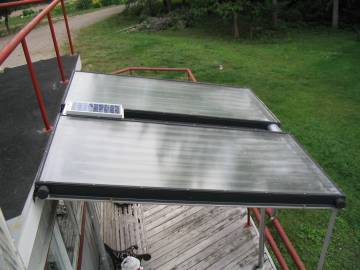Home/office renewable energy
A case study
Solar Domestic Hot Water

Home/office renewable energyA case studySolar Domestic Hot Water |

|
|
In winter we produce our domestic hot water (DHW) using the wood
stove. Several years ago we installed a pair of solar thermal
panels to heat our water in summer. Solar DHW is probably the single most
cost effective and simple technology in our renewable energy system.
In a lucky bit of serendipity, the panels form a very nice awning over the kitchen window, shielding it from the summer sun (see the photo below). |
Why
are we investing in renewables? |
| We bought a pair of used panels that had been removed
from a commercial building in Kingston. These are big, at four by eight
feet each, and crude, with eight passes of 1/2" copper pipe bonded
to black anodized plates inside. We picked them up used for $300 each. I
fabricated the frame from stout aluminum angle.
The simplicity and probable inefficiency of the design seems to be more than made up for by sheer size because when the sun shines, these things really make a lot of hot water. It is a rare day in summer when we have to resort to the oil-fired water heater in the basement. The small photovoltaic panel between the DHW panels is a 12V, 20W unit coupled directly to the same small pump that moves water through the wood stove circuit in winter. The solar DHW system is nice because the pump is active only while the sun is on the PV panel so the system looks after its own pump control. This whole DHW system cost just over $1000, which is a bargain compared to all other aspects of our system.
The DHW panels viewed from the kitchen. A little industrial looking, maybe, but an effective awning. |